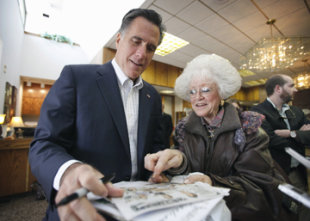The Optoma ML500 ($650 street) doesn't fit in any of the usual projector categories. Like pico and palmtop projectors, it uses LEDs rather than a traditional lamp, and it's only a little heavier than a large palmtop. On the other hand, it's brighter than any palmtop, offers much higher resolution, and it plugs in with a power cord like standard projectors rather than an external power block. However you classify it, though, it's a capable business projector that's small and light enough to carry with you without a second thought.
In some ways, the ML500 is similar to the ViewSonic PJD2121 ($450 street, 4 stars), another projector that's hard to classify. Both weigh less than 3 pounds but the rated brightness for both is modest by traditional sub-3 pound micro projector standards. The 1,700-lumen rating for the ViewSonic PJ260D ($999 street, 3.5 stars), for example, is far higher than the PJD2121's 400 lumens or the ML500's 500 lumens. On the other hand, traditional micro projectors tend to cost more as well, so you might think of the ML500 and PJD2121 as budget-priced micro projectors.
Basics
The ML500 is built around a WXGA (1280 by 800) DLP engine that uses red, green, and blue LEDs rather than a color wheel for its primary colors. It weighs in at 2.5 pounds and measures just 1.7 by 8.7 by 6.7 inches (HWD). Optoma even supplies a soft carrying case to help make it even more portable
Setup is standard, with the projector offering a surprisingly large number of connectors for its size, including a VGA port for a computer or component video source, an HDMI port for a computer or video source, and both S-video and composite video ports. In addition, there's a miniplug jack for audio input or audio plus composite video with an appropriate adaptor, a USB Type A port for reading files from a USB memory key, a mini USB port for sending a data image from the computer as well as transferring files to the 2GB internal memory, and an SD card slot.
As you might guess from the memory options, the ML500 offers a menu similar to the ones you'll find on some pico and palmtop models for opening files directly, whether from built-in memory, a USB key, or a memory card. More important, it can read most common image, video, and audio file formats, plus PDF files and Microsoft PowerPoint, Word, and Excel files. Load the files you need in memory, and there's no need to bring a computer or video source with you, a neat trick that makes the ML500 that much more portable.
Brightness, Image Quality, and Other Issues
With even lightweight projectors like the Editors' Choice Optoma GT750E ($800 street, 4 stars) offering brightness ratings at 3,000 lumens and higher, the ML500's 500 lumen rating doesn't sound like a lot. But keep in mind that perception of brightness is logarithmic, so that for any given size image, you'll perceive a 500 lumen image as much more than one sixth as bright as a 3,000 lumen image. What that translates to is that I was able to run my tests with our usual 2-meter (78-inch) wide image without problems. Even at that size, the image can stand up to moderate ambient light.
The projector also scored reasonably well for data image quality on our standard suite of DisplayMate tests. One issue that stood out, however, was scaling artifacts (unwanted extra patterns added to repeating patterns, like an area filled with dots) at the ML500's claimed native resolution. These artifacts come from a projector adding or dropping pixels, so it can scale an image in one resolution to fit the number of pixels in its LCD or DLP chip. By definition, a projector shouldn't have to scale an image that's already in its native resolution, so the artifacts suggest that the ML500's true native resolution isn't 1,280 by 800.
Optoma says that the mirrors on the DLP chip are arranged in a way that's designed to produce higher brightness from a more compact design. However, the mirror arrangement also makes it impossible to have a true native resolution in the traditional sense, so the projector does indeed scale the image. Note too that scaling is also likely responsible for a slight sense of soft focus that I also noticed. The good news is that the obvious scaling artifacts show only on images with repeating patterns over a large area.
On the plus side, the projector delivers vibrant, fully saturated color, including yellow, which often turns into a mustard color on DLP projectors. And although I saw slight pixel jitter with an analog connection on screens that are designed to bring out the problem, it was so subtle I almost missed it even though I was looking for it.
I also saw very little rainbow effect with data images. Rainbow artifacts, with bright areas breaking up into red-green-blue rainbows, are always a concern for single chip DLP projectors because of the way they create color. With the ML500, however, they showed rarely enough with data images so that even if you're sensitive to them, as I am, it's unlikely you'll find them annoying.
Unfortunately, I can't say the same for video images, where the rainbows showed up often enough so to make them a potential issue for anyone in your audience who's sees the effect easily. That alone makes the ML500 best reserved for short video clips only. Beyond that, it's usable for video, but not particularly impressive. I saw some posterization (colors changing suddenly where they should change gradually) and a moderate problem handling shadow detail (losing detail based on shading in dark areas), but only in scenes that tend to cause these problems. Both issues are common in data projectors.
Also worth mention is that the ML500's audio is surprisingly good for such a small projector. The single 2-watt speaker puts out enough volume to fill a small conference room, and the quality is good enough to easily make out spoken words.
Finally, keep in mind that the LED light source, with its 20,000 hour expected lifetime, will last the life of the projector. That makes the ML500 less expensive in the long run than a similarly priced projector with a standard lamp that you'll have to replace.
As a portable projector, the Optoma ML500 offers a particularly attractive balance of features. It's bright enough to project a reasonably large image even with ambient light; it's small and light enough to carry with you even when you're not sure you'll need it; and its ability to show files from memory can make it the only thing you need to carry. The combination makes it a terrific choice as traveling companion for business.
More Projector Reviews:
??? Optoma ML500
??? Epson MegaPlex MG-850HD Projector
??? Optoma Pro160S
??? Optoma HD33
??? Optoma DP-MW9080A
?? more
Source: http://feedproxy.google.com/~r/ziffdavis/pcmag/~3/C0cWs9i3dL0/0,2817,2395279,00.asp
fsu football ted kennedy warren zevon caroline kennedy caroline kennedy day of rage sportscenter












